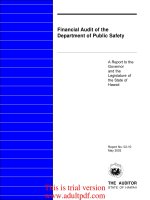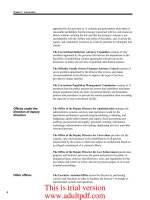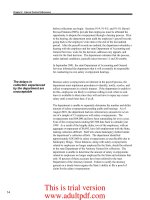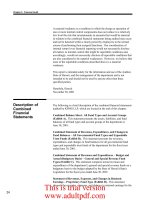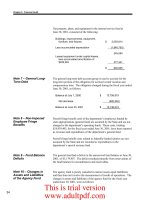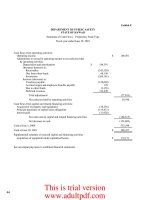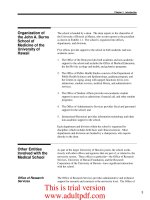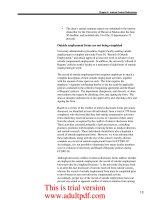FINANCIAL AUDIT First Audit of the Library of Congress Discloses Significant Problems _part5 ppt
Bạn đang xem bản rút gọn của tài liệu. Xem và tải ngay bản đầy đủ của tài liệu tại đây (947.56 KB, 10 trang )
Appendix III
Consolidated Statement of Financial Podtion
ofthe LibraryofCongreaefortheFlacalYear
Ending September 30,1998
Conrolldated Statement of Financial Position
September 30, 1988
(dollars in thousands)
Assets
Funds with U.S. Treasury (note 3)
Accounts Receivable, Net (note 4)
Permanent Loan to U.S. Treasury (note 5)
Investments (note 6)
Inventories (note 7)
Future Appropriations (note 8)
Library Collection (note 9)
Property and Equipment,
Net
of
$132,499
35,113
5,048
326,251
1,900
9,878
Accumulated Depreciation (note
10)
72,577
Other Assets
135
Total Assets
$583,401
Liabilities and Equity
Liabilities
Accounts Payable (note 12)
Amounts Due to Treasury (note 13)
Accrued Payroll and Benefits (note
1)
Accrued Annual Leave
Advances From Others (note 14)
Obligations Under Capital Leases (note
11)
Amounts Due Copyright Owners (note
6)
Total liabilities
Equity of the U.S. Government
Invested Capital (note 15)
Unexpended Appropriations (note 16)
Cumulative Results of ODerations (note 17)
$ 25,283
1,449
11,865
10,017
46,499
9,855
321,555
426,523
63,756
73,314
(574)
Fund Balances
Total equity of the U.S. Government
Total Liabilities and Equity
$583,401
201382.
156,878
The accompanying notes are an integral part of this financial
statement.
Page 39
GAO/AFMD-91-13 First Audit of the Library of Ckmgress
This is trial version
www.adultpdf.com
Appendix JII
Conoolidated Statement of Financial Position
of the
Library
of Congress for the FWCJII Year
Ending September 30,
ifief3
Notes to the Consolidated Statement of Financial Position
Note 1:
Significant Accounting Policies
A.
Accounting Entity and Basis of Consolidation
The Library of Congress is an agency in the legislative branch of
the federal government.
It
was
founded in
1800
primarily to
provide information and policy analyses to the members and
committees of the Congress.
Since then, the Library has been
assigned other major missions such as administering the U.S.
copyright laws and
a
national program to provide reading material
for blind and physically handicapped residents of the U.S. and its
territories and for U.S.
citizens residing abroad.
The Library
supports the
nation’s
libraries and helps them establish
bibliographic control (through classification and categorization)
over the world's publishing. It also administers the various gift
and trust funds donated to the Library.
The Library's programs and operations are subject to oversight
by
the Joint Committee on the Library which comprises
members
of the
U.S. Senate and
House
of Representatives. The Library relies
primarily on appropriated funds to support its programs and
operations.
Its
request
for these funds is subject to review
by
the House and Senate Appropriations Committees' Subcommittees on
Legislative Branch Appropriations.
The Library also receives
funds from other agencies for services provided under the Economy
Act
and other statutes.
In addition,
the Library receives
donations from the public in the form of gifts and trusts.
The
trust
funds are controlled by the Library of Congress Trust Fund
Board, which consists of the Librarian of Congress (who is
Chairman
and Secretary of the Trust Fund Board), the Chairman of
the Joint Committee on the Library,
the Secretary of the Treasury,
and two members from the private sector.
Fiscal year 1988 was the first year the Library has prepared
external financial statements and subjected them to audit by the
U.S. General Accounting Office (GAO).
As a legislative branch
agency, the Library is not required to follow the
executive agency
accounting principles established by the Comptroller General under
31 U.S.C. 3511.
These standards, referred to as generally
accepted accountins principles (GAAP) for federal agencies, are
contained in Title-2-of GAT)'s Policy and Procedures-Manual for
Guidance of Federal Agencies. However, the Library maintains its
fund balances with the Department of the Treasury and submits
information required
by Tkeasury
to incorporate its financial and
budget data into the overall federal government structure.
Therefore,
for purposes of this financial statement, the Library
has chosen to follow the reporting requirements of Title 2.
Page 40 GAO/AFMDBl-13 First Audit of the Library of Congress
This is trial version
www.adultpdf.com
Appendix III
Consolidated Statement of FInanti Position
of the Library of Congrees for the Fiscal Year
Ending September 90,1999
Title 2 requires federal agencies to annually issue four
consolidated financial statements: (1) statement of financial
position, (2) statement of operations,
(3) statement of changes in
financial position, and
(4)
statement of reconciliation to the
budget. Since this was the Library's first attempt to comply with
these reporting requirements,
it prepared only the consolidated
statement of financial position for the year ended September 30,
1988.
The accompanying consolidated statement of financial position has
been prepared using the accrual basis of accounting.
All
significant intra-agency balances and transactions have been
eliminated in consolidation. The statement includes the accounts
of all funds under the Library's control in fiscal year
1988.
These include 15 general fund accounts, 12 service fee funds
(originally established as gift funds), 58 trust funds, and 107
gift funds. The general funds are combined to form a single fund
type i
the service fee funds are combined to form a second fund
type ;
the gift and trust funds are combined with the Payments to
Copyright Owners'
Fund to form a third fund type. (See note 19.)
B. Recognition of Financing Sources
The Library receives the majority of the funding needed to support
its programs through appropriations.
The Library receives both
annual and multiyear appropriations that may be used, within
statutory limits,
for operating and capital expenditures
(primarily equipment, furniture, and furnishings). Additional
amounts are obtained through reimbursements for services performed
for other federal agencies as authorized by the Economy Act and
the Library's annual appropriation legislation. Also,
the Library
receives gifts from donors and interest on invested funds. In
addition,
the Library operates several self-sustaining service fee
funds which generate revenues from sale of various products and
services to the public and federal customers.
Appropriations are recognized as revenues at the time they are
used to pay expenses. Other revenues are recognized when earned.
Major Sources of the Library's Funding in Fiscal Year 1988
Source
Appropriations
Reimbursements for services
Service fee receipts
Gift and trust receipts
Total fiscal year 1988 funding
Amount
(in thousands)
$253,388
74,493
4,427
5,372
$337,680
Page 41 GAO/AFMD-91-13 First Audit of the Library of Congress
This is trial version
www.adultpdf.com
Appendix IJl
ConeoUdated Statement of Financial Position
of the Library of Conepees for the Natal Year
Ending September 30,1988
A future financing source is recognized for unfunded expenses such
8s annual leave earned but not taken. The
value
of such leave is
estimated to be about $9.9 million at the end of fiscal year
1988
and is shown aa a liability in the financial statements.
Accrued
annual leave in the amount of
$139,000
for the service fee accounts
is funded.
C.
Translation of Currencies
The Library of Congress receives and utilizes foreign currencies
in carrying
out
operations abroad. It conducts business through
six overseas offices and
uses
local currencies.
At year-end,
account balances remaining in foreign currencies are translated to
U.S. dollar equivalents at the uniform governmentwide Treasury
reporting rates.
D.
Property and Equipment
Property and equipment is valued at acquisition cost and includes
equipment purchased by the Library and that acquired through
capital leases. It does not include the land, buildings, and
improvements used by the Library, as discussed in the next
paragraph. Depreciation is computed on a straight-line basis
using estimated useful lives ranging from 5 to 20 years.
Land, buildings, and improvements have been excluded because they
are under the custody and control of the Architect of the Capitol.
This arrangement currently involves the Thomas Jefferson, James
Madison,
and John Adams buildings.
Costs associated with the
acquisition and maintenance of these buildings are accounted for
by
the Architect.
In fiscal year
1988,
the Architect spent
$16.3 million to pay for the cost of operating these buildings.
E.
Inventories
The Library's inventories are comprised, primarily, of unissued
supplies that will be consumed in future operations and
small
amounts
of materials used to reproduce printed materials and sound
recordings for
both internal
and external sales.
Consumable
operating supplies are valued at cost using a first-in first-out
(FIFO) method of valuation.
F.
Accrued Leave
Employee annual leave is accrued as it is earned, and the
accrual
is reduced when leave is taken.
At least once per year, the
amount is adjusted to reflect the current pay rates for the annual
leave hours each employee has earned but not used
(usually at the
end of the fiscal year).
All sick and other types of leave are
expensed as taken.
Page 42
GAO/APMD-91-13 Pirst Audit of the Library of Congress
This is trial version
www.adultpdf.com
Appendix III
ConsoUdati Statement of Financial Position
of the Library of C!ongress for the Fiscal Year
Ending September 30,19S9
G.
Accrued Payroll and Benefits
Accrued Payroll and Benefits consists of unpaid personnel
compensation and employee benefits accrued to Library employees as
of September 30,
1988.
Note 2:
Accounting for Intergovernmental Activities
The financial activities of the Library of Congress interact with
and depend on other federal government agencies.
Thus, the
Library's statement of financial position does not reflect all
financial decisions and activities applicable to it as if it were
a stand-alone entity.
A.
The Library's consolidated statement of financial position is
not intended to report the agency's share of the federal deficit
or of public borrowings,
including interest thereon.
B.
The Library of Congress is authorized to provide to other
federal libraries and agencies services such as automated library
information and other data
base
retrieval services through data
base
vendors and in-house research studies.
These services are
provided on a cost reimbursement basis.
C.
The majority of the Library's employees participate in the
Civil Service Retirement
System
(CSRS), to which the Library makes
matching contributions (7 percent of pay).
The Library does not,
however, report CSRS assets, accumulated plan benefits, or unfunded
liabilities, if any,
applicable to its employees.
Reporting such
amounts is the responsibility of the Office of Personnel
Management.
On January
1, 1987,
the Federal Employees Retirement
System
(FERS)
went into effect pursuant to Public Law 99-335. Most employees
hired after December 31,
1983,
are automatically covered by FERS
and Social Security. Employees hired prior to January
1, 1984,
can
elect to either join FERS and Social
Security
or remain in CSRS. A
primary feature of FERS is that it offers a savings plan to which
the Library automatically contributes
1
percent of pay and then
matches any employee contribution up to an additional 4 percent of
pay.
For
most
employees hired since December 31,
1983,
the Library also
contributes the employer's matching share for Social Security.
The following
table
shows the
amounts
the Library contributed to
the retirement plans and Social Security in fiscal year
1988.
Page 43
GAO/AFMD-91-13 First Audit of the Library of Congress
This is trial version
www.adultpdf.com
Appendix III
Consolidated Statement of Finaucial Position
of the Library of cOugre~ss for the Fiscal Year
Endlng September 30,lBSS
Library Contributions to Retirement Plans During 1988
Paid to
Amount
fin Ehousandsl
CSRS
FERS
Social Security
$ 8,465
3,327
2,284
$
D. Certain legal actions to which the Library may be a named
party are administered and, in some instances, litigated by other
federal agencies. Legal actions to which the Library is a litigant
are covered by the Federal Tort Claims Act.
Generally, amounts
(over $2,500 for Federal Tort Claims Act cases) to be paid under
any decision, settlement, or award pertaining to these litigations
are paid from the Treasury's Claims, Judgments, and Relief Acts
Fund.
Several legal actions brought by or on behalf of Library
employees were pending at fiscal year-end, with a total loss
exposure in excess of $18 million.
However,
the Library's
management and legal counsel do not believe these actions will
result in
a
material loss to the Library or the government. Since
the Library, except for contract dispute payments, is not required
to reimburse this fund for payments made on its behalf, the
decision to make such payments is not reflected in the Library's
statement of financial position.
Note 3:
Funds With U.S. Treasury
The amount shown as Funds with U.S. Treasury represents the
balances of the appropriated, service fee, and gift and trust
funds that are on deposit with the U.S. Treasury as well as
undeposited amounts that were on hand at the end of the fiscal
year and the various imprest funds.
Note 4: Receivables
Receivables,
as of September 30, 1988, consisted of accounts
receivable, interest accrued on copyright royalties invested in
market-based Treasury securities, and travel advances.
The major
portion of accounts receivable resulted from billings to other
federal agencies under interagency agreements for data base
retrieval and other library services. When originally
established, these receivables represented requests for advance
payments to which the Library had claim as the contracted services
were performed. However, the Library's accounts receivable
accounting procedures do not distinguish between that portion of
the year-end accounts receivable balance that represents requests
for unearned advances and that portion that represents receivables
to which the Library is entitled.
Page 44
GAO/AFMD-91-13 First Audit of the Library of Congress
This is trial version
www.adultpdf.com
Appendix III
Coneolidated Statement of Financin.l Poaitlon
of the Library
of
Congress
for the Fiscal Year
Ending September go,1988
The table below shows the accounts receivable balance at the end of
fiscal year 1988.
Accounts Receivable as of September 30,
1988
ACCOUntS
Source
receivable
(in thousands)
Other federal agencies
$36,001
The public
Less allowance for losses
(l,3Y)
34,737
Interest due on
copyright royalties invested 195
Travel advances 181
Total net accounts receivable
$35.113
Note 5:
Permanent Loan to U.S. Treasury
Under 2 U.S.C.
158, up to
$10
million of Library trust funds may be
invested with the United States Treasury as a perpetual loan at a
variable interest rate of at least four percent per annum,
As of September 30, 1988, the trust funds had $5,048,091 invested
in the permanent loan to the U.S. Treasury at an interest rate of
8-l/2 percent.
Note 6: Investments
Investments as of September 30, 1988, consist of market-based
Treasury securities, marketable Treasury securities, and other
investments that include both debt and equity instruments of
private sector business entities.
The market-based Treasury
securities, which are nonmarketable, were purchased with the
jukebox and cable TV royalties collected by the Copyright Office
on behalf of copyright owners.
These investments will be held in
trust until distributions to copyright owners are authorized by
the Copyright Royalty Tribunal.
The marketable Treasury and other
securities were obtained and are held by the trust funds under the
conditions set forth in the respective trust instruments.
The other marketable securities are valued at cost while the
Treasury securities are valued at cost less unamortized discounts
and premiums.
The investments purchased with copyright royalties
are valued at cost since premiums and discounts are not amortized.
Because they are held in a custodial capacity, income does not
accrue to the Library's benefit.
-
Page 45 GAO/AFMD-91-13 First Audit of the Library of Congress
This is trial version
www.adultpdf.com
Appendix III
ConsolidatedStatement
ofFinancialPo&ion
of the Library of C!ongre~ for the Fiecal Year
Ending September 80,1988
The next table shows cost and market values of investments.
Values of Investments as of September 30, 1988
Market-based
Treasury securities
Marketable
Treasury securities
Other marketable securities
Total
cost
Market
(thousands)
$321,112
n/a
1,364 $1,300
3,775 3,779
$-
Note 7:
Inventories
As of September 30, 1988, the Library's inventories consisted of
operating supplies, work-in-process, and photo duplication
production materials. The Library does not have adequate
inventory systems to fully account for these amounts.
While shown
for financial reporting purposes in the Library's 1988
consolidated financial statement,
the Library has not recorded all
of these estimated amounts in its official accounting records.
The
inventories are valued at cost using the FIFO method of valuation.
The following estimated amounts,
shown in the following table,
were compiled from available Library records during the course of
GAO's audit.
Estimated Inventory on Hand as of September 30, 1988
Type inventory
Operating supplies
Work-in-process:
Photoduplication
Recorded sound lab
Photoduplication materials
Total
Amount
(in thousands)
$1,539
64
95
202
$1,900
Note 8:
Future Appropriations
Future appropriations represent the future funding needed to pay
for unfunded annual leave that was earned but not taken as of the
end of the fiscal year.
This leave, estimated to be $9.9 million
at fiscal year-end, is not funded through appropriations until it
is taken. An equal amount has been recognized as a financing
source in order to properly match expenses and revenues. The
annual leave liability of $10 million also includes $139,000 for
funded accrued annual leave of the service fee funds.
Page 46
GAO/AFMD-91-13 Fit Audit of the Library of Congress
This is trial version
www.adultpdf.com
Appendix III
Consolidated Statement of Financial Position
of the Library of Congress for the Fiscal Year
Ending September 30,lBsS
Note 9:
Library Collection
The value shown in the
table below
for the Library's collection, as
of September 30,
1988, was
estimated based on a limited valuation
of the nearly 89 million items constituting the collections at that
time.
This approach was necessary
because
the cost records for
most of the items are no longer
available.
The quantities were
taken from Library records that had been accumulated over the
years.
The
value
was determined based on the best judgment of the
managers responsible for the
various
categories of the collection.
Estimated Value of Each Category of Collection Items as of
September 30, 1988
Category
Quantity
Book collection
Audio material
Manuscripts
Maps
Microforms
Print material/print products
Visual material
Rare music
String instruments and bows
Flutes
Rare books
Total
211697,724
1,302,800
36,563,392
3,919,ooo
7,343,209
5,272,075
12,255,365
38a
37
1,651
611,933
88,967,224
Value
(in mirrrons)
$ 823
14
128
475
110
115
3,902
193
12
1 ,ooil
$6,773
aRepresents
musical
collections rather than single items.
Each
collection comprises varying numbers of items.
The
value
is based
on each collection as a whole.
Note 10:
Property and Equipment
Property and equipment consists primarily of operating equipment,
ADP software,
production equipment at contractor facilities,
equipment on loan to the public,
and furniture and furnishings.
Operating equipment consists of pieces of serialized equipment
(containing manufacturer's serial
number)
such as computers,
printers,
and typewriters,
which have an acquisition price greater
than $300.
ADP software consists of software purchased from outside vendors.
It does not include leased software.
Equipment at contractor facilities consists of tooling machinery
provided to contractors engaged in repairing equipment such as
cassette players specially developed for the blind and physically
handicapped.
Page 47
GAO/AFMD-91-13 First Audit of the Library of Congress
This is trial version
www.adultpdf.com
Appendix III
ConedMated Statement of Financial Poddon
of the
Ubrary of Congrees for the Fiscal Year
Ending September 80,1989
Equipment on loan to the public consists of equipment such as
cassette players specifically developed for use
by
the blind and
physically handicapped.
The
Library
does not have adequate property systems to fully
account for its property and equipment.
As a result, the amounts
shown are estimates based on available Library records.
These
estimates will not be recorded in the Library's accounting records
until its accounting system has been upgraded to track and maintain
such data.
The balance for furniture and furnishings has been derived from
budget records because accounting data is not available.
The next table shows property and equipment at the end of fiscal
year
1988.
Property and Equipment as of September 30, 1988
Accumulated Book
Category
Operating equipment
Leased equipment
ADP software
Equipment at contractor
facilities
Equipment on loan to
public
Furniture and
furnishings
Total
cost
$28,500
14,672
2,749
1,635
65,607
24,453
$
+g$gi$$) vS?v
$15,707
$12,793
5,857
8,815
1,109
1,640
286 1,349
32,174
33,433
9,906
14,547
$65,039
$72,577
Note
11:
Leasing Arrangements
As of September 30,
1988,
the Library was committed to various
capital and operating leases amounting to $13.2 million and
$2.2 million, respectively.
All leases are cancelable at the
Library's discretion, generally without penalty.
All of the
operating leases are contracted for
1 year.
Capital leases,
especially those covering computer equipment, contain purchase
options which permit transfer of ownership to the Library at the
end of the lease term.
The following table shows future minimum lease payments required
under capital leases.
This table is based on available Library
records because the Library does not have an adequate financial
system to account for capital leases, These estimates will not
be
recorded in the Library's accounting records until the systems have
been upgraded to track and maintain data on capital leases.
Page 48
GAO/AFMD-91-13 First Audit of the Library of Congress
,./
This is trial version
www.adultpdf.com
